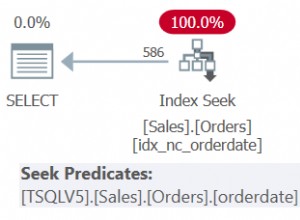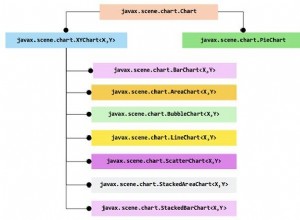Einführung
Es kommt häufig vor, dass eine MS SQL Server-Transaktion vom Initiator vergessen wird. Das beste Beispiel wäre das folgende:In SSMS wird ein Skript ausgeführt, das über die Anweisung „begin tran“ eine Transaktion startet und ein Fehler auftritt; „commit“ oder „rollback“ gehen jedoch nicht durch und der Ausführungsinitiator hat diese Abfrage lange verlassen. Infolgedessen treten immer mehr Schwankungen auf, wenn es darum geht, die Abfragen zu blockieren, die den Zugriff auf abgeschlossene Ressourcen (Tabellen und Serverressourcen wie RAM, CPU und das Eingabe-Ausgabe-System) anfordern.
In diesem Artikel sehen wir uns eine der Möglichkeiten an, wie Sie den Prozess zum Löschen vergessener Transaktionen automatisieren können.
Die Lösung
Definieren wir eine vergessene Transaktion als eine aktive (derzeit ausgeführte) Transaktion, die während einer ausreichend großen Zeitspanne T keine aktiven (derzeit ausgeführten) Abfragen hat.
Hier ist der allgemeine Algorithmus zum Löschen solcher Transaktionen:
- Erstellen einer Tabelle zum Speichern und Analysieren von Informationen über aktuell vergessene Transaktionen sowie einer Tabelle zum Sortieren und Archivieren der aus der ersten Tabelle ausgewählten Transaktionen nach Löschaktionen.
- Sammeln von Informationen (Transaktionen und ihre Sitzungen, die keine Abfragen haben, d. h. die Transaktionen, die innerhalb einer bestimmten Zeitspanne T ausgeführt und vergessen wurden.
- Aktualisieren der Tabelle mit allen derzeit vergessenen Transaktionen, die wir in Schritt 1 erhalten haben (wenn eine vergessene Transaktion eine aktive Abfrage erhalten hat, wird eine solche Transaktion aus dieser Tabelle gelöscht).
- Abrufen der Sitzungen, die wir beenden müssen (eine Sitzung hat mindestens eine Transaktion, die ab Schritt 1.000 oder öfter als vergessen in die Tabelle eingefügt wurde, und die Sitzung hatte genauso oft eine fehlende aktive Abfrage).
- Archivieren der Daten, die wir löschen werden (Details zu den Sitzungen, Verbindungen und Transaktionen, die beendet werden).
- Löschen der ausgewählten Sitzungen.
- Löschen der verarbeiteten Einträge zusammen mit denen, die nicht entfernt werden können und zu lange in der Tabelle aus Schritt 1 waren.
Sehen wir uns nun an, wie wir diesen Algorithmus implementieren können.
Zunächst müssen wir eine Tabelle erstellen, um die Informationen über alle derzeit vergessenen Transaktionen zu speichern und zu analysieren:
USE [DB_NAME] GO SET ANSI_NULLS ON GO SET QUOTED_IDENTIFIER ON GO CREATE TABLE [srv].[SessionTran]( [SessionID] [int] NOT NULL, [TransactionID] [bigint] NOT NULL, [CountTranNotRequest] [tinyint] NOT NULL, [CountSessionNotRequest] [tinyint] NOT NULL, [TransactionBeginTime] [datetime] NOT NULL, [InsertUTCDate] [datetime] NOT NULL, [UpdateUTCDate] [datetime] NOT NULL, CONSTRAINT [PK_SessionTran] PRIMARY KEY CLUSTERED ( [SessionID] ASC, [TransactionID] ASC )WITH (PAD_INDEX = OFF, STATISTICS_NORECOMPUTE = OFF, IGNORE_DUP_KEY = OFF, ALLOW_ROW_LOCKS = ON, ALLOW_PAGE_LOCKS = ON) ON [PRIMARY] ) ON [PRIMARY] GO ALTER TABLE [srv].[SessionTran] ADD CONSTRAINT [DF_SessionTran_Count] DEFAULT ((0)) FOR [CountTranNotRequest] GO ALTER TABLE [srv].[SessionTran] ADD CONSTRAINT [DF_SessionTran_CountSessionNotRequest] DEFAULT ((0)) FOR [CountSessionNotRequest] GO ALTER TABLE [srv].[SessionTran] ADD CONSTRAINT [DF_SessionTran_InsertUTCDate] DEFAULT (getutcdate()) FOR [InsertUTCDate] GO ALTER TABLE [srv].[SessionTran] ADD CONSTRAINT [DF_SessionTran_UpdateUTCDate] DEFAULT (getutcdate()) FOR [UpdateUTCDate] GO
Hier:
1) SessionID – Sitzungskennung
2) TransactionID – vergessene Transaktionskennung
3) CountTranNotRequest – wie oft eine Transaktion als vergessen registriert wurde
4) CountSessionNotRequest – wie oft eine Sitzung ohne aktive Abfragen wurde registriert und hatte eine vergessene Transaktion
5) TransactionBeginTime — Datum und Uhrzeit der Einleitung der vergessenen Transaktion
6) InsertUTCDate — Datum und Uhrzeit der Eintragserstellung (UTC)
7) UpdateUTCDate – Datum und Uhrzeit der Eintragsaktualisierung (UTC)
Als Nächstes erstellen wir eine Tabelle zum Archivieren und sortieren die Transaktionen aus der ersten Tabelle nach Löschaktionen:
[expand title =”Code „]
USE [DB_NAME] GO SET ANSI_NULLS ON GO SET QUOTED_IDENTIFIER ON GO CREATE TABLE [srv].[KillSession]( [ID] [int] IDENTITY(1,1) NOT NULL, [session_id] [smallint] NOT NULL, [transaction_id] [bigint] NOT NULL, [login_time] [datetime] NOT NULL, [host_name] [nvarchar](128) NULL, [program_name] [nvarchar](128) NULL, [host_process_id] [int] NULL, [client_version] [int] NULL, [client_interface_name] [nvarchar](32) NULL, [security_id] [varbinary](85) NOT NULL, [login_name] [nvarchar](128) NOT NULL, [nt_domain] [nvarchar](128) NULL, [nt_user_name] [nvarchar](128) NULL, [status] [nvarchar](30) NOT NULL, [context_info] [varbinary](128) NULL, [cpu_time] [int] NOT NULL, [memory_usage] [int] NOT NULL, [total_scheduled_time] [int] NOT NULL, [total_elapsed_time] [int] NOT NULL, [endpoint_id] [int] NOT NULL, [last_request_start_time] [datetime] NOT NULL, [last_request_end_time] [datetime] NULL, [reads] [bigint] NOT NULL, [writes] [bigint] NOT NULL, [logical_reads] [bigint] NOT NULL, [is_user_process] [bit] NOT NULL, [text_size] [int] NOT NULL, [language] [nvarchar](128) NULL, [date_format] [nvarchar](3) NULL, [date_first] [smallint] NOT NULL, [quoted_identifier] [bit] NOT NULL, [arithabort] [bit] NOT NULL, [ansi_null_dflt_on] [bit] NOT NULL, [ansi_defaults] [bit] NOT NULL, [ansi_warnings] [bit] NOT NULL, [ansi_padding] [bit] NOT NULL, [ansi_nulls] [bit] NOT NULL, [concat_null_yields_null] [bit] NOT NULL, [transaction_isolation_level] [smallint] NOT NULL, [lock_timeout] [int] NOT NULL, [deadlock_priority] [int] NOT NULL, [row_count] [bigint] NOT NULL, [prev_error] [int] NOT NULL, [original_security_id] [varbinary](85) NOT NULL, [original_login_name] [nvarchar](128) NOT NULL, [last_successful_logon] [datetime] NULL, [last_unsuccessful_logon] [datetime] NULL, [unsuccessful_logons] [bigint] NULL, [group_id] [int] NOT NULL, [database_id] [smallint] NOT NULL, [authenticating_database_id] [int] NULL, [open_transaction_count] [int] NOT NULL, [most_recent_session_id] [int] NULL, [connect_time] [datetime] NULL, [net_transport] [nvarchar](40) NULL, [protocol_type] [nvarchar](40) NULL, [protocol_version] [int] NULL, [encrypt_option] [nvarchar](40) NULL, [auth_scheme] [nvarchar](40) NULL, [node_affinity] [smallint] NULL, [num_reads] [int] NULL, [num_writes] [int] NULL, [last_read] [datetime] NULL, [last_write] [datetime] NULL, [net_packet_size] [int] NULL, [client_net_address] [nvarchar](48) NULL, [client_tcp_port] [int] NULL, [local_net_address] [nvarchar](48) NULL, [local_tcp_port] [int] NULL, [connection_id] [uniqueidentifier] NULL, [parent_connection_id] [uniqueidentifier] NULL, [most_recent_sql_handle] [varbinary](64) NULL, [LastTSQL] [nvarchar](max) NULL, [transaction_begin_time] [datetime] NOT NULL, [CountTranNotRequest] [tinyint] NOT NULL, [CountSessionNotRequest] [tinyint] NOT NULL, [InsertUTCDate] [datetime] NOT NULL, CONSTRAINT [PK_KillSession] PRIMARY KEY CLUSTERED ( [ID] ASC )WITH (PAD_INDEX = OFF, STATISTICS_NORECOMPUTE = OFF, IGNORE_DUP_KEY = OFF, ALLOW_ROW_LOCKS = ON, ALLOW_PAGE_LOCKS = ON) ON [PRIMARY] ) ON [PRIMARY] TEXTIMAGE_ON [PRIMARY] GO ALTER TABLE [srv].[KillSession] ADD CONSTRAINT [DF_KillSession_InsertUTCDate] DEFAULT (getutcdate()) FOR [InsertUTCDate] GO
[/expandieren]
Hier werden alle Felder aus den Systemdarstellungen „sys.dm_exec_sessions“ und „sys.dm_exec_connections“ übernommen und „InsertUTCDate“ gibt die UTC-Zeit an, zu der der Eintrag erstellt wurde.
Um die verbleibenden Schritte abzuschließen, implementieren wir dann die gespeicherte Prozedur [srv].[AutoKillSessionTranBegin] wie folgt:
[expand title =”Code „]
USE [DB_NAME]
GO
SET ANSI_NULLS ON
GO
SET QUOTED_IDENTIFIER ON
GO
CREATE PROCEDURE [srv].[AutoKillSessionTranBegin]
@minuteOld int, --age of the executed transaction (T min.)
@countIsNotRequests int --amount of times it has been placed into the table (K)
AS
BEGIN
SET NOCOUNT ON;
SET TRANSACTION ISOLATION LEVEL READ UNCOMMITTED;
declare @tbl table (
SessionID int,
TransactionID bigint,
IsSessionNotRequest bit,
TransactionBeginTime datetime
);
--retrieving information (transactions and theirs session which have no requests, i.e, transactions that were initiated and forgotten)
insert into @tbl (
SessionID,
TransactionID,
IsSessionNotRequest,
TransactionBeginTime
)
select t.[session_id] as SessionID
, t.[transaction_id] as TransactionID
, case when exists(select top(1) 1 from sys.dm_exec_requests as r where r.[session_id]=t.[session_id]) then 0 else 1 end as IsSessionNotRequest
, (select top(1) ta.[transaction_begin_time] from sys.dm_tran_active_transactions as ta where ta.[transaction_id]=t.[transaction_id]) as TransactionBeginTime
from sys.dm_tran_session_transactions as t
where t.[is_user_transaction]=1
and not exists(select top(1) 1 from sys.dm_exec_requests as r where r.[transaction_id]=t.[transaction_id]);
--refreshing the table containing all initiated transactions with no requests
;merge srv.SessionTran as st
using @tbl as t
on st.[SessionID]=t.[SessionID] and st.[TransactionID]=t.[TransactionID]
when matched then
update set [UpdateUTCDate] = getUTCDate()
, [CountTranNotRequest] = st.[CountTranNotRequest]+1
, [CountSessionNotRequest] = case when (t.[IsSessionNotRequest]=1) then (st.[CountSessionNotRequest]+1) else 0 end
, [TransactionBeginTime] = t.[TransactionBeginTime]
when not matched by target then
insert (
[SessionID]
,[TransactionID]
,[TransactionBeginTime]
)
values (
t.[SessionID]
,t.[TransactionID]
,t.[TransactionBeginTime]
)
when not matched by source then delete;
--list of sessions which need to be deleted (those that contain forgotten transactions)
declare @kills table (
SessionID int
);
--детальная информация для архива
declare @kills_copy table (
SessionID int,
TransactionID bigint,
CountTranNotRequest tinyint,
CountSessionNotRequest tinyint,
TransactionBeginTime datetime
)
--gathering the sessions we need to kill
--a session has at least one transaction which was marked as having no requests @countIsNotRequests times
--and this session was marked as having no active requests the same amount of times
insert into @kills_copy (
SessionID,
TransactionID,
CountTranNotRequest,
CountSessionNotRequest,
TransactionBeginTime
)
select SessionID,
TransactionID,
CountTranNotRequest,
CountSessionNotRequest,
TransactionBeginTime
from srv.SessionTran
where [CountTranNotRequest]>[email protected]
and [CountSessionNotRequest]>[email protected]
and [TransactionBeginTime]<=DateAdd(minute,[email protected],GetDate());
--archiving the data we need to delete (details on the sessions to be deleted, connections and transactions)
INSERT INTO [srv].[KillSession]
([session_id]
,[transaction_id]
,[login_time]
,[host_name]
,[program_name]
,[host_process_id]
,[client_version]
,[client_interface_name]
,[security_id]
,[login_name]
,[nt_domain]
,[nt_user_name]
,[status]
,[context_info]
,[cpu_time]
,[memory_usage]
,[total_scheduled_time]
,[total_elapsed_time]
,[endpoint_id]
,[last_request_start_time]
,[last_request_end_time]
,[reads]
,[writes]
,[logical_reads]
,[is_user_process]
,[text_size]
,[language]
,[date_format]
,[date_first]
,[quoted_identifier]
,[arithabort]
,[ansi_null_dflt_on]
,[ansi_defaults]
,[ansi_warnings]
,[ansi_padding]
,[ansi_nulls]
,[concat_null_yields_null]
,[transaction_isolation_level]
,[lock_timeout]
,[deadlock_priority]
,[row_count]
,[prev_error]
,[original_security_id]
,[original_login_name]
,[last_successful_logon]
,[last_unsuccessful_logon]
,[unsuccessful_logons]
,[group_id]
,[database_id]
,[authenticating_database_id]
,[open_transaction_count]
,[most_recent_session_id]
,[connect_time]
,[net_transport]
,[protocol_type]
,[protocol_version]
,[encrypt_option]
,[auth_scheme]
,[node_affinity]
,[num_reads]
,[num_writes]
,[last_read]
,[last_write]
,[net_packet_size]
,[client_net_address]
,[client_tcp_port]
,[local_net_address]
,[local_tcp_port]
,[connection_id]
,[parent_connection_id]
,[most_recent_sql_handle]
,[LastTSQL]
,[transaction_begin_time]
,[CountTranNotRequest]
,[CountSessionNotRequest])
select ES.[session_id]
,kc.[TransactionID]
,ES.[login_time]
,ES.[host_name]
,ES.[program_name]
,ES.[host_process_id]
,ES.[client_version]
,ES.[client_interface_name]
,ES.[security_id]
,ES.[login_name]
,ES.[nt_domain]
,ES.[nt_user_name]
,ES.[status]
,ES.[context_info]
,ES.[cpu_time]
,ES.[memory_usage]
,ES.[total_scheduled_time]
,ES.[total_elapsed_time]
,ES.[endpoint_id]
,ES.[last_request_start_time]
,ES.[last_request_end_time]
,ES.[reads]
,ES.[writes]
,ES.[logical_reads]
,ES.[is_user_process]
,ES.[text_size]
,ES.[language]
,ES.[date_format]
,ES.[date_first]
,ES.[quoted_identifier]
,ES.[arithabort]
,ES.[ansi_null_dflt_on]
,ES.[ansi_defaults]
,ES.[ansi_warnings]
,ES.[ansi_padding]
,ES.[ansi_nulls]
,ES.[concat_null_yields_null]
,ES.[transaction_isolation_level]
,ES.[lock_timeout]
,ES.[deadlock_priority]
,ES.[row_count]
,ES.[prev_error]
,ES.[original_security_id]
,ES.[original_login_name]
,ES.[last_successful_logon]
,ES.[last_unsuccessful_logon]
,ES.[unsuccessful_logons]
,ES.[group_id]
,ES.[database_id]
,ES.[authenticating_database_id]
,ES.[open_transaction_count]
,EC.[most_recent_session_id]
,EC.[connect_time]
,EC.[net_transport]
,EC.[protocol_type]
,EC.[protocol_version]
,EC.[encrypt_option]
,EC.[auth_scheme]
,EC.[node_affinity]
,EC.[num_reads]
,EC.[num_writes]
,EC.[last_read]
,EC.[last_write]
,EC.[net_packet_size]
,EC.[client_net_address]
,EC.[client_tcp_port]
,EC.[local_net_address]
,EC.[local_tcp_port]
,EC.[connection_id]
,EC.[parent_connection_id]
,EC.[most_recent_sql_handle]
,(select top(1) text from sys.dm_exec_sql_text(EC.[most_recent_sql_handle])) as [LastTSQL]
,kc.[TransactionBeginTime]
,kc.[CountTranNotRequest]
,kc.[CountSessionNotRequest]
from @kills_copy as kc
inner join sys.dm_exec_sessions ES with(readuncommitted) on kc.[SessionID]=ES.[session_id]
inner join sys.dm_exec_connections EC with(readuncommitted) on EC.session_id = ES.session_id;
--gathering sessions
insert into @kills (
SessionID
)
select [SessionID]
from @kills_copy
group by [SessionID];
declare @SessionID int;
--deleting sessions
while(exists(select top(1) 1 from @kills))
begin
select top(1)
@SessionID=[SessionID]
from @kills;
BEGIN TRY
EXEC sp_executesql N'kill @SessionID',
N'@SessionID INT',
@SessionID;
END TRY
BEGIN CATCH
END CATCH
delete from @kills
where [SessionID][email protected];
end
select st.[SessionID]
,st.[TransactionID]
into #tbl
from srv.SessionTran as st
where st.[CountTranNotRequest]>=250
or st.[CountSessionNotRequest]>=250
or exists(select top(1) 1 from @kills_copy kc where kc.[SessionID]=st.[SessionID]);
--Deleting the processed entries along with those that cannot be removed and have been in the table for too long
delete from st
from #tbl as t
inner join srv.SessionTran as st on t.[SessionID] =st.[SessionID]
and t.[TransactionID]=st.[TransactionID];
drop table #tbl;
END
GO [/expandieren]
Schritt 7 des Algorithmus wird dadurch implementiert, dass einer dieser beiden Zähler – CountTranNotRequest oder CountSessionNotRequest – einen Wert von 250 erreicht.
Das Ergebnis
In diesem Artikel haben wir uns eine Implementierung eines Prozesses angesehen, der vergessene Transaktionen automatisch löscht.
Diese Methode ermöglicht es uns, den Löschvorgang für vergessene Transaktionen zu automatisieren. Dies führt zu einem Verringern oder Stoppen des Schwankungswachstums in der Blockierung, das durch solche Transaktionen erzeugt wird. So wird die DBMS-Leistung vor Aktionen geschützt, die zu vergessenen Transaktionen führen können.
Quellen:
» sys.dm_exec_requests
» sys.dm_tran_active_transactions
» sys.dm_tran_session_transactions
» sys.dm_exec_sql_text
» sys.dm_exec_sessions
» sys.dm_exec_connections
» KILL




